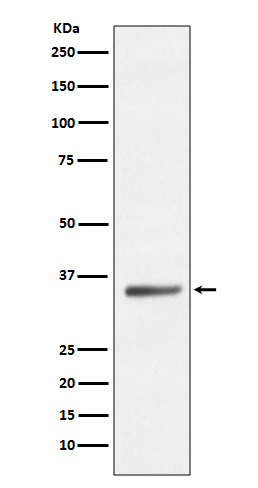
| WB | 咨询技术 | Human,Mouse,Rat |
| IF | 咨询技术 | Human,Mouse,Rat |
| IHC | 咨询技术 | Human,Mouse,Rat |
| ICC | 技术咨询 | Human,Mouse,Rat |
| FCM | 咨询技术 | Human,Mouse,Rat |
| Elisa | 咨询技术 | Human,Mouse,Rat |
| Aliases | SIR2-like protein 5; SIR2L5; Sirt5; Sirtuin 5; Sirtuin type 5;;SIRT5 |
| WB Predicted band size | 34 kDa |
| Host/Isotype | Rabbit IgG |
| Antibody Type | Primary antibody |
| Storage | Store at 4°C short term. Aliquot and store at -20°C long term. Avoid freeze/thaw cycles. |
| Species Reactivity | Human,Mouse |
| Immunogen | A synthesized peptide derived from human SIRT5 |
| Formulation | Purified antibody in PBS with 0.05% sodium azide,0.05% BSA and 50% glycerol. |
+ +
以下是关于SIRT5抗体的3篇参考文献,按发表时间排序:
---
1. **文献名称**: *SIRT5 Deacetylates Carbamoyl Phosphate Synthetase 1 and Regulates the Urea Cycle*
**作者**: Lombard, D.B. et al.
**摘要**: 研究揭示了SIRT5通过去乙酰化作用调控尿素循环中的关键酶CPS1.并验证了SIRT5抗体在检测线粒体定位及酶活性中的特异性应用。
---
2. **文献名称**: *SIRT5 Regulates the Mitochondrial Lysine Succinylome and Metabolic Reprogramming*
**作者**: Rardin, M.J. et al.
**摘要**: 本文利用SIRT5特异性抗体,结合质谱分析,发现SIRT5通过去琥珀酰化修饰调控线粒体代谢网络,影响能量代谢和酮体生成。
---
3. **文献名称**: *SIRT5 Deficiency Enhances Protein Succinylation and Alters Mitochondrial Metabolism*
**作者**: Park, J. et al.
**摘要**: 研究通过SIRT5抗体进行免疫印迹和免疫沉淀,证明SIRT5缺失导致线粒体蛋白琥珀酰化水平升高,影响三羧酸循环和氧化磷酸化功能。
---
4. **文献名称**: *SIRT5 Inhibits Bile Acid Synthesis via Suppressing CYP7A1 Expression*
**作者**: Zhang, Y. et al.
**摘要**: 使用SIRT5抗体进行ChIP-seq和Western blot分析,揭示SIRT5通过表观遗传调控抑制胆固醇代谢关键酶CYP7A1.从而调控胆汁酸合成。
---
以上文献均涉及SIRT5抗体的实验应用(如Western blot、免疫沉淀、亚细胞定位等),并聚焦于SIRT5在代谢调控中的分子机制。
SIRT5 antibodies are essential tools for studying the function and expression of Sirtuin 5 (SIRT5), a member of the sirtuin family of NAD⁺-dependent deacylases. SIRT5 is primarily localized in mitochondria and regulates post-translational modifications by removing succinyl, malonyl, and glutaryl groups from lysine residues on target proteins. It plays a critical role in metabolic pathways, including ketogenesis, fatty acid oxidation, and the urea cycle, impacting cellular energy homeostasis, stress responses, and apoptosis.
SIRT5 antibodies are widely used in techniques like Western blotting, immunohistochemistry (IHC), and immunofluorescence (IF) to detect SIRT5 expression levels, subcellular localization, and interaction partners. Their specificity is crucial, as commercial antibodies vary in performance across applications, requiring validation via knockout cell lines or tissues. Research involving SIRT5 antibodies has linked the protein to diseases such as cancer (where it may act as an oncogene or tumor suppressor), metabolic disorders, and neurodegenerative conditions. For instance, SIRT5 overexpression in certain cancers correlates with altered mitochondrial metabolism, while its deficiency has been implicated in cardiac and hepatic dysfunction.
These antibodies also aid in exploring SIRT5's therapeutic potential, as modulating its activity could influence age-related diseases or metabolic syndromes. However, challenges remain in standardizing antibody specificity and interpreting context-dependent roles of SIRT5 across tissues. Overall, SIRT5 antibodies are pivotal for unraveling the protein’s diverse biological functions and its implications in health and disease.
×